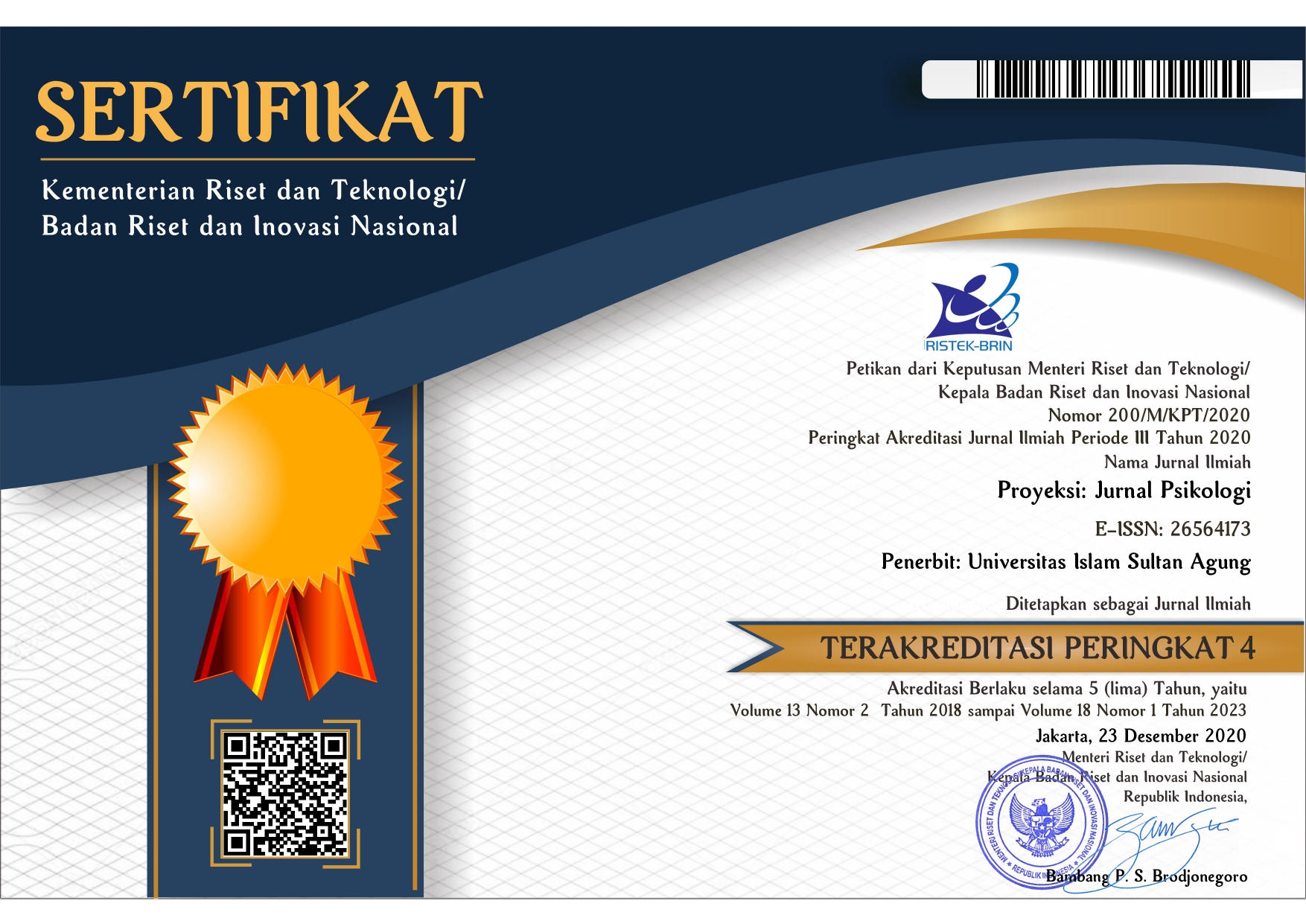PENGELOLAAN PERILAKU TANTRUM OLEH IBU TERHADAP ANAK USIA 12-48 BULAN
Abstract
Tantrum is a behavioral disorder experienced by 12-48 - month - child in form of emotional outbursts, for example: destructive behavior or verbally (crying, screaming, whining) over and over again. The reason behind that action is the difficulty of children to understand their feeling and emotion moreover, they have unstable emotions due to discomfort feelings or difficult to deliver what they feel and what they want to their parents or others. This study focused on how mothers manage children's emotions with Tantrum aged 12 - 48 months. Because this research focus on parents with tantrum children, researcher used purposive sampling to specify the subject and collect the data using in-depth interviews. Furthermore, the data was analyzed by Miles and Huberman Model. The result showed that four out of five subjects explicitly reveals that communication and emotional identification were more effective to decrease tantrum behavior gradually. Whereas, one of them use diversion to distract attention. However, it was an ineffective way because, children cannot understand the emotion they feel and how to deliver it in a good way. The result was children will manipulate the surrounding with the same emotion. In this study, the emotion was shown verbally, such as crying loudly and screaming.
Keywords
Full Text:
PDFReferences
Agustina Wulandari. (2013). Pelatihan Komunikasi Efektif untuk Meningkatkan Pengetahuan Ibu dalam Mengatasi Tantrum pada Anak Usia Prasekolah. Universitas Indonesia.
Badan Pusat Statistik. (2020). Profil Anak Usia Dini 2020. Jakarta : Badan Pusat Statistik.
Borba, M. (2009). tahune Big Book Parenting Solution: 101 Answers to Your Everyday Challenges and Wildest Worries. Jossey-Bass, A Wiley Imprint.
Chaplin, J. P. (2014). Kamus Lengkap Psikologi. Penerjemah. In Jakarta: PT Raja Grafindo Persada.
Devine, M., & Powell, M. (2008). Talent Management in tahune Public Sector. tahune Ashridge Journal, 1–6. https://doi.org/10.17573/cepar.2020.2.03
Einon, D., & Potegal, M. (1994). tahune Dynamics of Aggression: Biological and Social Processes in Dyads and Groups (M. Potegal & J. Knutson (eds.); 1st ed., p. 368). Psychology Press. https://doi.org/https://doi.org/10.4324/9780203772317
Hasan, Maimunah.. (2011). Pendidikan Anak Usia Dini. Yogyakarta: Diva Press.
Herawati, N. I. (2012). Menghadapi Anak Usia Dini Yang Temper Tantrum. Cakrawala Dini: Jurnal Pendidikan Anak Usia Dini, 3(2). https://doi.org/10.17509/cd.v3i2.10338
Hurlock, Elizabetahun B. (2010). Psikologi Perkembangan Suatu Pendekatan Sepanjang Rentang Kehidupan. Jakarta: Erlangga.
Jacobson, B. & Fetsch. (2013). Children’s Anger and Tantrums. United States: Colorado State University Extension.
Kartono, Kartini. (1991). Bimbingan Bagi Anak dan Remaja yang Bermasalah. Jakarta: Rajawali Press.
Kirana, R. (2013). Hubungan Pola Asuh Orang Tua dengan Temper Tantrum pada Anak Pra Sekolah (Studi Kasus di Dusun Ngemplak). Skripsi Jurusan Psikologi Fakultas Ilmu Pendidikan Universitas Negeri Semarang.
Mashar, Riana. (2011). Emosi Anak Usia Dini dan Strategi Pengembangannya. Jakarta: Kencana
Miller, C. (2020). Why Do Kids Have Tantrums and Meltdowns?. New York: Child Mind Institute. Diakses 5, Desember 2020 dari https://childmind.org/article/why-do-kids-have-tantrums- and-meltdowns/.
Mireault, G., & Trahan, J. (2007). Tantrums and Anxiety in Early Childhood: A Pilot Study © tahune Autahunor ( s ) 2007 Tantrums and Anxiety in Early Childhood : A Pilot Study Gina Mireault Johnson State College. Early Childhood Research and Practice, 9(2), 1–11. http://ecrp.uiuc.edu/v9n2/mireault.html
Potegal, M & Davidson J., M. (2003). Temper Tantrum in Young Children : Behavioral Composition. Developmental and Behavioural Pediatric Journal Vol. 24(3).
Rahayuningsih, S. I. (2014). Strategi Ibu Mengatasi Perilaku Temper Tantrum Pada Anak Usia Toddler Di Rumah Susun Keudah Kota Banda Aceh. Idea Nursing Journal, 5(1).
Rahmah, Nur Faizah dan Ali Gufron. (2012). Mendesain Perilaku Anak Sejak Usia Dini. Surakarta: Adi Citra Cemerlang.
Rini Hildayani, dkk. 2009. Penanganan Anak Berkelainan (Anak Dengan Kebutuhan Khusus). Jakarta : Universitas Terbuka.
Salkind, Neil J. (2002). Child Development. New York: Macmillan Reference USA.
Supriyanti, E., & Hariyanti, T. B. (2019). Strategi Mengatasi Temper tantrum Pada Anak Usia 3-5 Tahun Melalui Permainan Ular Tangga di TK Wilayah Tumpang Kabupaten Malang. Jurnal Wiyata, 001, 13–20.
Watson, T. Steuart. Tonya Watson, dan Sarah Gebhardt. (2010). Temper Tantrums: Guidelines for Parents and Teachers. Oxford: Miami University.
Wulandari, A. (2013). Pelatihan Komunikasi Efektif untuk Meningkatkan Pengetahuan Ibu dalam Mengatasi Tantrum pada Anak Usia Prasekolah. Tesis Fakultas Psikologi Program Studi Ilmu Psikologi Peminatan Terapan Psikologi Anak Usia Dini, Universitas Indonesia.
DOI: http://dx.doi.org/10.30659/jp.16.2.%25p
Refbacks
- There are currently no refbacks.

Proyeksi by http://jurnal.unissula.ac.id/index.php/proyeksi/ is licensed under a Creative Commons Attribution-ShareAlike 4.0 International License.

